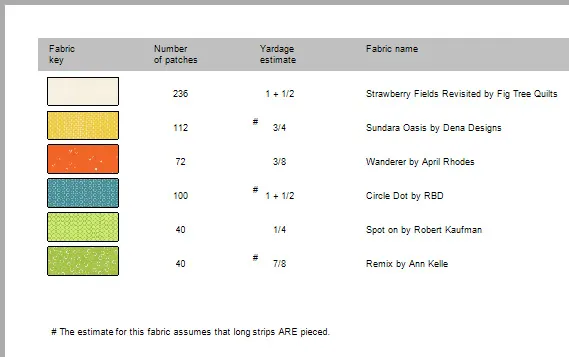When you are ready to print the yardage, click FILE > Print and then click Fabric Yardage. The Print Fabric Yardage box appears. You can also print yardage by clicking the Print tool on the top toolbar, then choose Fabric Yardage from the menu.
Choose the width of the fabric using the drop-down box, and type the seam allowance width that you want EQ to use when calculating the yardage.
The Preview button will display a summary chart of the fabrics used in the quilt including a small swatch of each fabric, the name of the fabric and the amount needed of each. Clicking the Print button will send the yardage chart straight to the printer for printing. The print box will close.

About Yardage Estimates
EQ will estimate the fabric yardage required for your quilt. Remember that these are estimates. You may find you need more or less fabric depending on how you cut out your pattern or whether you are using a special combination sewing cutting method which has you trim fabric after sewing.
It is recommended that you buy an amount equal to the amount of fabric you need, plus enough to cut an extra piece in case you make a mistake.
How EQ figures yardage
- It adds the seam allowance you select to each patch.
- For patches that can be rotary cut, it places the patches in rectangular strips as you would for rotary cutting. For patches that can’t be rotary cut, it places an imaginary rectangle around each patch.
- It places these rectangles on fabric of the selected width. Each time a row is filled, it begins a new row counting the entire strip as required yardage.
For quilts in which most patches can be rotary cut, the result is a very “tight” estimate of the yardage required. It assumes that you rotary cut the fabric in an efficient way.
If many patches cannot be rotary cut, then the yardage is likely to be a generous overestimate. This is because placing each patch in an imaginary rectangle does not account for the “packing” that’s possible when you’re looking at a specific situation.
Notes About Calculation
- Borders. EQ gives yardage for rectangles that are longer than the fabric width as if they were pieced. This applies also to the mitered borders.
- Compare the rotary cutting instruction from EQ to see how the yardage calculator “lays out” patches on the fabric. For example: Half-square and quarter-square triangles are laid out in rectangles that contain two or four triangles respectively. Be aware that the yardage calculator treats a triangle as quarter-square if its long edge (hypotenuse) is either vertical or horizontal in the quilt. If the two shorter edges of the triangle are horizontal and vertical respectively, then the triangle is assumed to be cut as a half-square triangle.
- Many shapes can be treated by EQ as rotary cuttable. The following figures show how EQ “packs” a number of familiar shapes for yardage calculation.
| Half-square triangle |  |
 |
|
| Quarter-square triangle |  |
 |
|
| Half-rectangle triangle |  |
 |
|
| General triangle |  |
 |
|
| Parallelogram (diamonds) |  |
 |
 |
| Trapezoid |  |
 |

 EQ Mini
EQ Mini

